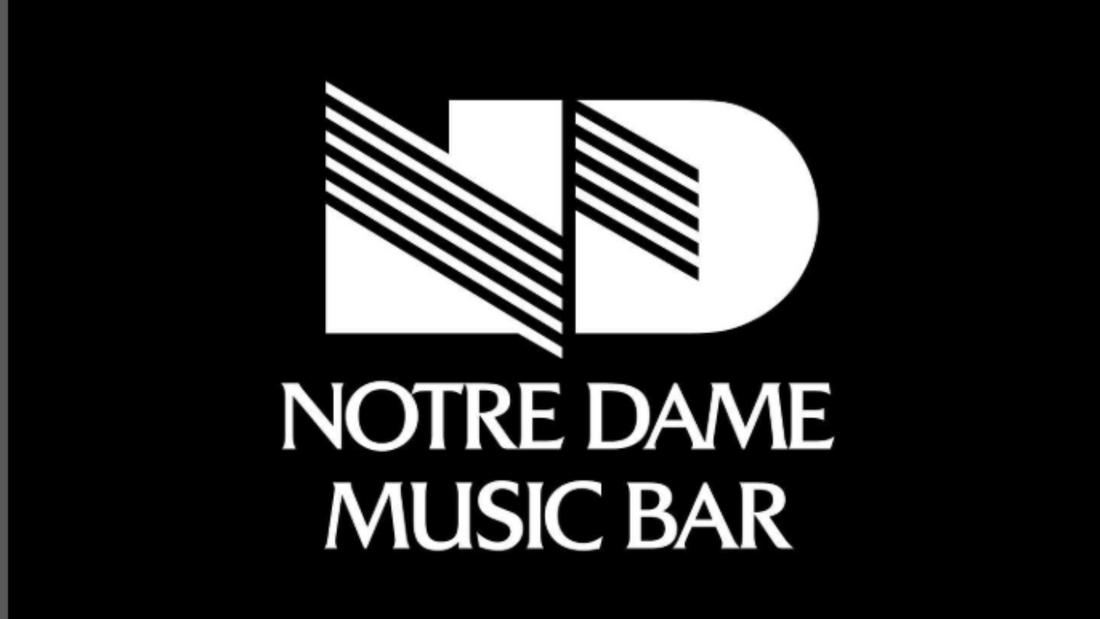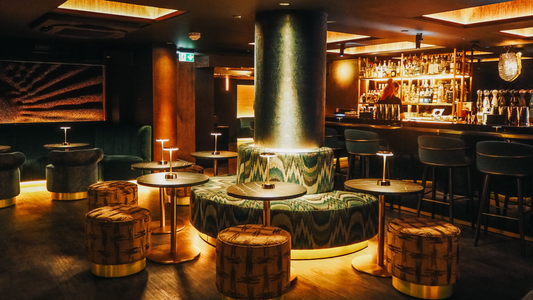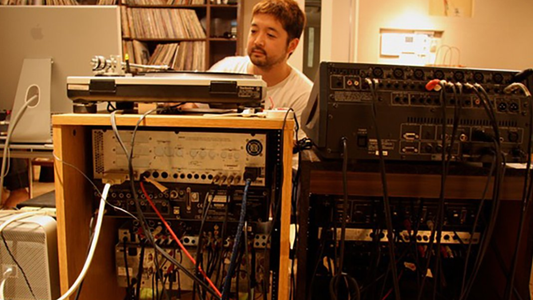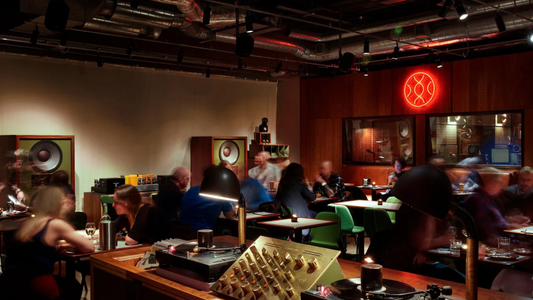
The Quiet is Tuned: Notre Dame Music Bar’s Warm Fidelity in the 11ᵉ
By Rafi Mercer
New Listing
Notre Dame Music Bar is one of Paris’s most respected listening bars — explore more in our Paris Music Venues guide.
Venue Name: Notre Dame Music Bar
Address: 6 Rue Émile Lepeu, 75011 Paris, France
Website: instagram.com/notredame_musicbar
Phone: N/A
Spotify Profile: N/A
Paris does night like it does perfume — layered, lingering, memorable before you’ve even named it. On Rue Émile Lepeu, a modest door opens to a bar that smells faintly of citrus peel and lacquered wood, and the evening breathes differently from the first step inside. The room is small, shapely, and already humming at a human volume; Notre Dame Music Bar has the posture of a secret: upright, considered, ready to listen.
Seats aren’t scattered so much as composed, arranged with the same attention a sound engineer gives to a stereo image. Tables sit low; banquettes anchor the sidewalls; the bar itself is a thin ribbon of light and bottles, nothing theatrical, everything intentional. You don’t fight for space. You find your place and the room takes care of the rest.
The first track of my night begins before I’ve seen the sleeve. It’s a tenor sax line with the breath still hanging on the reed, and the sound arrives not as volume but as presence — the kind that makes you look up and locate the speakers even if you’d rather play it cool. Over my left shoulder: JBL boxes with that vintage geometry that signals tone over trend. In the rack: McIntosh glass glowing soft green, the kind of hardware that holds a note like it remembers how the note was made. (If you know, you know; if you don’t, you will by the end of the evening.)
What’s striking isn’t loudness — it’s scale. The kick drum touches the floorboards and comes back through your feet. A cymbal decays out into the room and seems to curl around the edges of the lamps before it disappears. Piano chords have a weight that isn’t heavy; they’re just there, three‑dimensional, like hands.
The record wall glows: roughly two thousand sleeves, a mosaic of colour and typography. It’s an index of where the night can go — classic jazz with French pressings in the spine, a lean of soul that will lift the room at the right hour, West African highlife waiting like a late‑night promise, dub records with handwritten price stickers still clinging to their corners. You could stand in front of those shelves for two hours and learn more about how Paris listens now than in a dozen gig listings.
There’s no grand sermon about rules here, but the culture is known. No big groups; no reservations; listening first. The staff carry it lightly — a nod to quieten a voice, a finger to the lips timed with the last bars of a piano solo, a drink placed without fuss so the fade‑out stays uninterrupted. The bar is a choreography: shaker, stir, pour, place — all in a tempo that sits inside the record rather than fighting it.
I start with a highball because the room suggests it — cold, bright, calibrated for length not show. It does that Japanese miracle of feeling like water and tasting like a decision. Later there’s a pour of wine, something low‑intervention and just on the point of opening, and it rides the midrange like it was blended for horn and brush.
The selector is a quiet conspirator. They work with album sides more than singles, and when they do mix, the changeover is more seam than cut — a tempo nudge to carry the story rather than a flex of skill. We drift from late‑’60s modal into a Brazilian record where the percussion is a geography lesson, and then a Parisian private‑press curiosity that nobody at my table had heard but all of us pretend we had. This is what listening bars do when they’re honest: they make discovery feel communal without turning it into a quiz.
The room’s acoustics are simple — no obvious foam stuck to walls, no skyline diffusers shouting for attention — just proportions that keep reflections civil and a ceiling that knows how to soften a snare without swallowing it. The mix position is generous; you can sit almost anywhere and feel like you’re in the sweet spot. That’s a compliment reserved for very few spaces, and it separates polite sound from tuned sound.
Across from me, a couple lean forward at the same moment on the same sax phrase, double‑smiling the way people do when a take lands. At the bar, a solo regular raises their glass mid‑break, in salute to no one and everyone. In a corner, a trio speak in hand gestures and short words during a bass solo, because the rest is already being said. Listening has its body language, and Notre Dame reads it fluently.
Time slips. That’s how you know the room is working. Two hours dissolve into one coherent piece instead of twelve separate tracks. The outside world pops in occasionally — a scooter’s Doppler note down the street; a murmur at the door; a faint draught every time someone slips in — and then it’s gone again under the weight of what’s in the air. I find myself watching the selector’s hands as much as hearing the selection: the careful lift of a tonearm, the grip on a sleeve’s open edge, the little smile when a first bar comes in precisely at the right bar of silence.
Paris has embraced this kissa‑adjacent culture with a particular elegance. Fewer rules than Tokyo, more attention than a standard bar; the compromise is better manners, in both sound and company. Notre Dame sits at the centre of that curve, a place where you can come alone with intent, or with a friend who understands why the song, just now, is the conversation.
There’s a late‑night arc that many rooms get wrong — the part where the energy wants to lift but the fidelity wants to hold. Here, it’s handled like a handover rather than a cliff. Tempo’s a notch up, the bass a little fatter, the records less melancholy, but the head never starts to ache. Someone might sway by the bar; nobody tries to turn the bench into a dance floor. If you want that, the 11ᵉ will oblige you three streets away. If you want to remain in the song, you stay put.
When the last side of the night spins, there’s a hush that’s more than silence; it’s consensus. The room agrees to leave together. Coats are pulled on slowly, glasses drained in two sips rather than one, and people stand to trace their route toward the door with eyes that aren’t quite ready to engage with weather. Outside, the street is polite. The city’s wider rhythm is still there, but quieter; your steps find the record’s tempo even though the record is done.
On the walk back, you rehear the bar. You hear the JBL’s roundness in the throb of a bus at the junction, and a McIntosh shimmer in the overhead wires when the wind slips past them. That’s what a good listening room does — it retunes you, not just its own walls. You go home with the evening still mixing down in your head, and you realise you’ve not just had a night out; you’ve invested in a memory you can play back without a needle.
Notre Dame won’t suit everyone, and that’s the point. It isn’t a party. It’s a practice. It rewards the person who sits, sips, and listens; who lets an album side finish even though they’d like to Instagram the moment; who understands that fidelity is another way of saying respect — for the record, for the room, for each other. And in a quarter of the city where spectacle is cheap and volume is one twist of a dial away, restraint like this feels radical.
Leave it to Paris to make quiet feel luxurious.
Rafi Mercer writes about the spaces where music matters. For more stories from Tracks & Tales, subscribe, or click here to read more.
Explore More: See our Listening Bars collection for venues worldwide.







